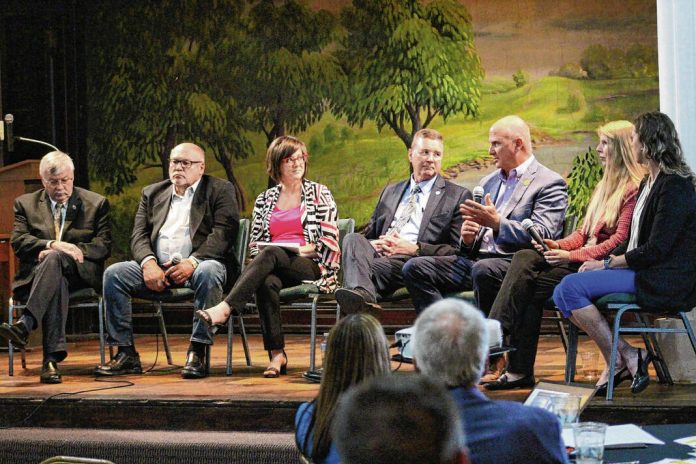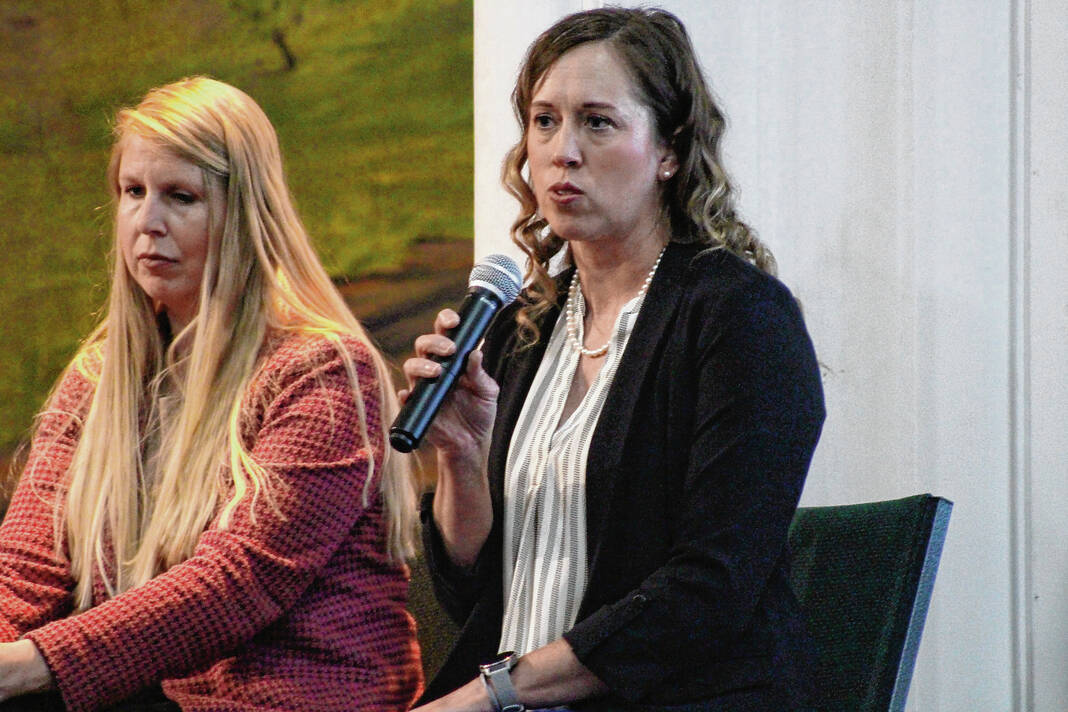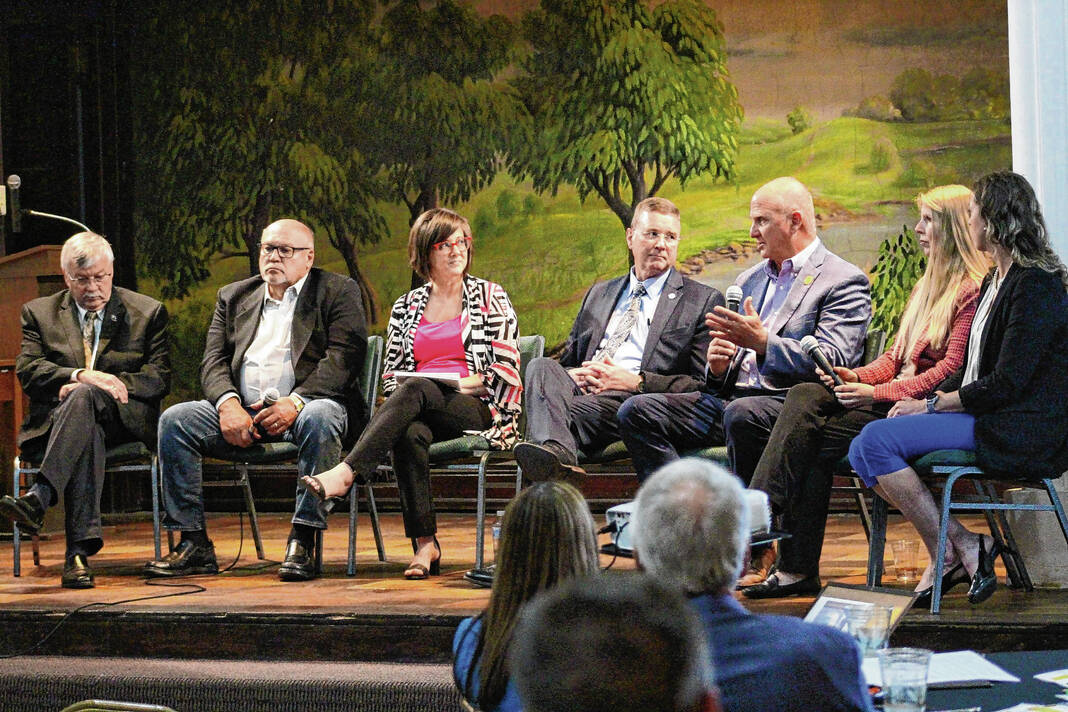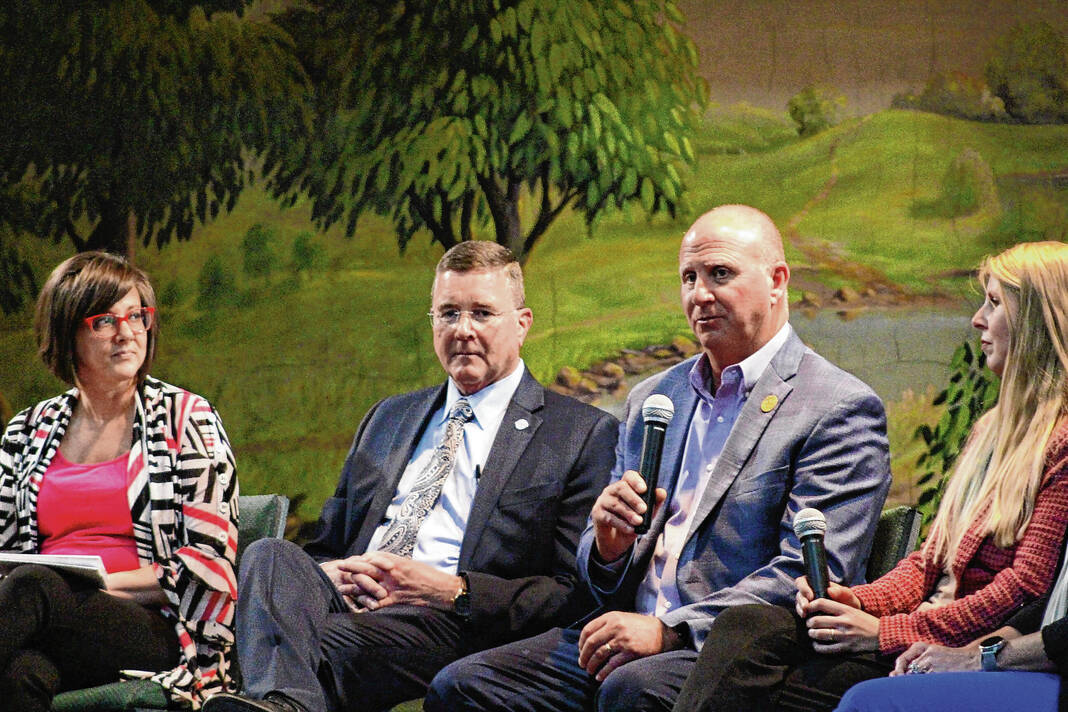Leaders from the county, city and town governments talked about elections, economic development, and the recent tornadoes at an annual county chamber event last week.
Franklin Mayor Steve Barnett, Bargersville Town Manager Dan Cartwright, New Whiteland Clerk-Treasurer Angela DeVoss, Greenwood Mayor Mark Myers, County Commissioner Kevin Walls, Edinburgh Community Development Director SaraBeth Drybread and Whiteland Acting Town Manager Carmen Young sat together on a panel to answer questions generally about the state of each of their governments.
This event was the third annual Municipal Matters Luncheon hosted by Aspire Johnson County on May 18 at the Johnson County Museum of History in Franklin.
Leaders from each municipality and Johnson County government told business leaders in the room about different projects they have in the works, and they also discussed the March 31 tornados, and how the disaster affected each of them.
Tornado response
The town of Whiteland took the brunt of the tornadoes that ripped through Johnson County on March 31. The EF-3 tornado that went through the town damaged over 120 homes, destroying 16. The first question of the event asked about how each community was affected by the storms that passed through that night.
Young talked about the initial mobilization of the town emergency teams, and assuring all the residents were OK. The town suffered no injuries or deaths after the tornado, and was able to account for everyone.
“Somebody above was watching and looking down on us to really protect us,” Young said.
One of the biggest takeaways from managing a disaster was collaborating with the other municipalities, Young said. Every community mobilized to help Whiteland after the tornado. Other municipalities offered help where they could by supplying street equipment, first responders and general support. New Whiteland stepped in and offered its fire station to the displaced Whiteland Fire Department after their station was torn up by the tornado.
Franklin had some damage from straight-line winds that took trees down and damaged power lines and buildings. The Johnson County Courthouse and the Historic Artcraft Theatre saw much of the damage.
“We thought we were hit pretty hard, but we really weren’t when you see Whiteland,” Barnett said. “Franklin was very lucky.”
Barnett jumped in to also help and quickly reached out to Young the night of the tornado, as did the other leaders.
Bargersville had an EF-0 touchdown in mainly rural areas, and power was knocked out for many residents. The town utility also provided electricity to many parts of Whiteland, so crews were out there working to get that restored, Cartwright said. Bargersville’s street department also helped.
Walls commended Stephanie Sichting, the county emergency management director, during the tornado discussions. She initiated a lot of the contact between federal and state agencies for emergency assistance and helped Whiteland with the command center.
“The collaboration among the people sitting up here right now in their agencies. You’re fortunate to live in Johnson County because I was proud to watch it come together. No questions. Just get it done,” Walls said.
Development and ARPA spending
Each leader laid out some projects their respective governments are currently working on.
Myers touted the Greenwood Fieldhouse, which opened last year. And he talked about The Madison mixed-use development being built around it, which will house over 300 luxury apartments. The leasing office is open, and some of the units have already been leased, Myers said. The entire project is expected to be complete by April, he said.
In Edinburgh, work on the State Road 252 corridor is starting in the next couple of years, Drybread said. She also brought up a controversial rezone proposal to build a Dollar General Market on State Road 252. Several residents have objected to the development of the store.
Cartwright touted different amenities coming to Bargersville. One big project opening soon is Kephart Park. The $3.5 million, six-acre park northeast of County Road 144 and Saddle Club Road will feature a splash pad, pickleball courts, restrooms, grills, a trail and playground equipment.
Johnson County has the largest populated unincorporated area in the state, with a lot of residents relying on county government to provide them services. Walls mentioned the unincorporated areas open for development and infrastructure along the Interstates 65 and 69 corridors.
He said the county has been looking for avenues to accomplish providing services to unincorporated residents. With that, he mentioned the county’s two new tax-increment finance districts, or TIFs, and jokingly said it “wasn’t a really favorable thing with the other two mayors.”
“The I-69 corridor is going to be the next big boom for Johnson County,” Walls said. “We’re planning and looking forward to that.”
Spending of the federal American Rescue Plan Act, or ARPA, was also brought up in the questioning. Each government doled out its money in different ways.
In Johnson County, which received around $31 million, a big ticket item ARPA money was spent on is the new health department and coroner building, Walls said. The new space is much larger than what both departments operate in now, so county officials have said this is a long-needed upgrade.
Other county projects Walls mentioned is money toward road and infrastructure improvements, as well as expanding broadband access with JC Fiber. The county is also planning on building a mental health building with some ARPA cash, but Walls declined to share many specific details about that during the event.
In Greenwood, Myers said the city used some of its $6.9 million in ARPA money to fund public safety, including getting a new ladder truck for the fire department. ARPA money was also doled out to the three school systems in Greenwood — Clark-Pleasant, Center Grove and Greenwood — for school safety upgrades.
Myers additionally said ARPA was put toward upgrading the city’s cybersecurity, which is important, he said.
“I hired a company to come in and look at our cybersecurity, and they broke into my system within three minutes,” Myers said. “That was very important that we got that upgraded, and I’m excited about that.”
New Whiteland is using ARPA money to replace some aging equipment for its fire and police departments, DeVoss said. Money is also going toward road and infrastructure projects.
Whiteland received a little over $1 million, Young said, and all of it went to public safety. The town purchases two new police cars, and increased pay for the fire department.
Franklin used ARPA money for upgrading the city’s wastewater treatment plant improvements. Barnett said a lot of issues at the plant were caused by people flushing “flushable” wipes down the toilet. ARPA money is also going to be used to upgrade the city’s Fire Station 21, which is the oldest station in Franklin, Barnett said.
A tough Greenwood election
The 2023 municipal primary was also a brief topic of discussion at the event.
Myers was the only elected official on the stage who had a challenger in the Republican primary, which the moderator, Jean Renk of Duke Energy, called a “hard-fought race.”
Myers was challenged by Republican Joe Hubbard, a former Center Grove School Board member. The race was highly contentious, with a lot of mud-slinging from both candidates and their supporters.
Renk asked Myers his takeaways from Election night.
“Thank God it’s over,” Myers said. “It was an exciting race for quite a few of us. A very tense race for a lot of us. In the end, the message that was put out is people like the city, they like that we’re growing, and they’re supporting the current administration.”
Barnett, who was unchallenged in the primary for Franklin mayor, said he “had the best election you could have” with no opponent. And his thoughts were primarily with Myers on Election night.
“We’d become friends over the years, and we rely on each other and talk to each other,” Barnett said. “I supported Mark all the way, and it turned out the way it should have turned out.”









